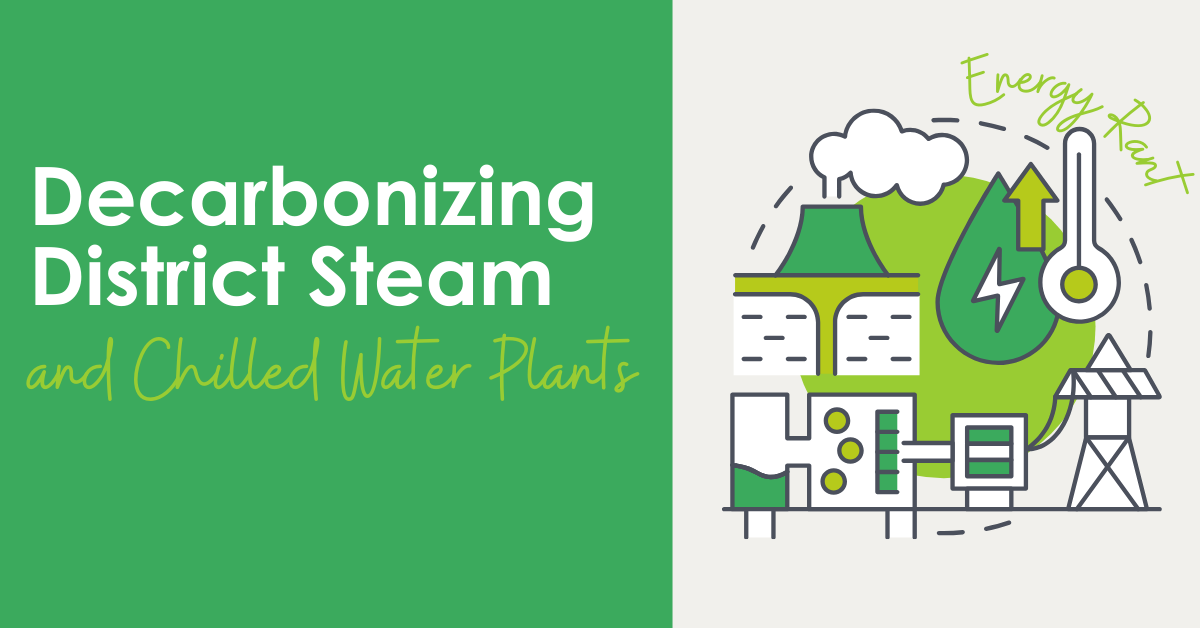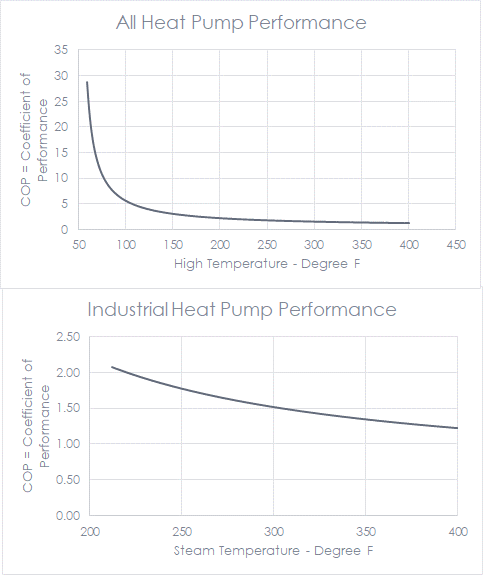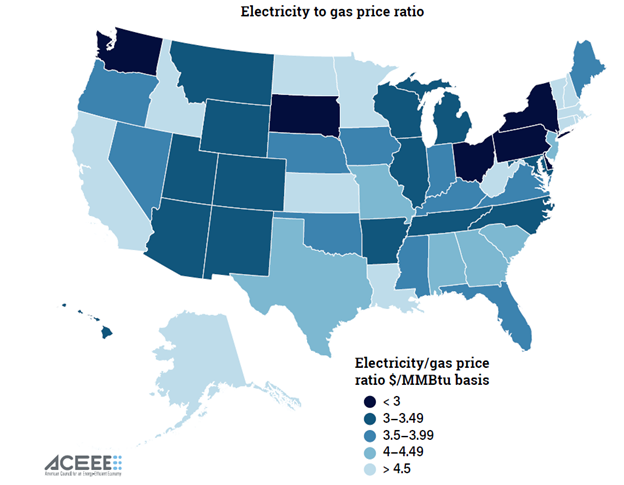
Let’s begin with Oxford Dictionary’s definition of decarbonization.
Noun: reduction or elimination of carbon dioxide emissions from a process such as manufacturing or the production of energy.
Last week, I introduced central or district plants that serve multiple buildings with steam, chilled water, and, in many cases, electricity. District plants serve colleges, healthcare, manufacturing campuses, and, in some cases, entire sections of cities. This week, I describe issues and strategies to save energy and decarbonize these plants.
As I learned early in my energy efficiency career, it is essential to understand the design logic behind the system before recommending modifications. Steam moves massive volumes of thermal energy with minimal driving force derived by boiling water to design pressure, say, 100 psi for a typical district heating plant. The pumping power to deliver a given amount of heat for a hot water system is at least ten times greater than a steam plant’s pumping power (condensate and boiler feedwater pump)[1]. Hot water requires about 25 times the mass flow of water than steam. Therefore, steam has a substantial advantage in the operating cost of delivery (pumps) and the system’s first cost (piping).
Here is a nice steam-system cartoon from Industrial Quick Search. Note the “Heating Unit” here could be a building, a bunch of buildings, or a steam coil, as shown. It is simply symbolic of the load on the boiler.
 Heat Pumps and Hot Water?
Heat Pumps and Hot Water?
One way to fully decarbonize a district steam system includes converting it to hot water and using heat pumps to meet heating loads at lower, more favorable temperatures. However, as detailed below, the efficiencies gained are puny compared to the exorbitant cost of replacing piping (more flow and larger pipes required as described above) and a lot of heating coils throughout campuses. Hot water coils require more heat transfer surface than hotter steam coils. I’ve done a thousand studies to convert to hot water. It never pays back. Many systems are converted to hot water over time as other mechanical systems need replacement, such as when air handlers and terminal heating equipment are at the end of their useful lifetimes.
Heat Pumps and Steam?
Assume you have a typical 100 psi district steam plant. Is replacing gas-fired steam boilers with heat pumps to serve these loads feasible? The saturated steam temperature at 100 psi for steam (the boiling point) is 338F. A reputable industrial heat pump manufacturer, Siemens, advertises heat pump temperatures up to 302F. Making 100 psi steam with a heat pump for a district plant is not going to work.
The Nature of Heat Pump Performance v Temperature
Looking closer at heat pump efficiency, I have the following performance from a model developed in this research paper. I used a generously warm 50F heat sink (earth, river, lake, ocean, etc.) for the calculations. The first chart shows theoretical heat pump performance over a broad range, from barely heating to 60F to 100 psi steam temperature. You can see that heat pump performance in the typical space-heating with direct expansion (e.g., Mitsubishi, Fujitsu, Daikin, etc.) air-to-air heat pumps is around 5 COP.
COP (Coefficient of Performance) = the heat delivered divided by the electrical energy consumed. It is unitless, so any energy unit can be used in the numerator and denominator. Using Btus, aka British thermal units, we have:

 The COP defines efficiency as the desired output divided by the cost. For space heating, let’s say the average COP for the air-to-air technology averages 4.0. Let’s also assume the competing efficiency of a gas furnace is 95%. The ratio is, therefore, about 4.2.
The COP defines efficiency as the desired output divided by the cost. For space heating, let’s say the average COP for the air-to-air technology averages 4.0. Let’s also assume the competing efficiency of a gas furnace is 95%. The ratio is, therefore, about 4.2.
A couple of years ago, the ACEEE published a fact sheet, Decarbonizing Industry with Heat Pumps, which includes the following graphic.
 Generally, states with electric-to-gas price ratios less than four, per the previous paragraph, are good fits for low-temperature heat pumps. Making steam or high-temperature hot water with heat pumps above 140F is not cost-effective compared to natural gas alternatives.
Generally, states with electric-to-gas price ratios less than four, per the previous paragraph, are good fits for low-temperature heat pumps. Making steam or high-temperature hot water with heat pumps above 140F is not cost-effective compared to natural gas alternatives.
District Heating and Cooling is Built to Last
District plants serving campuses and downtowns are like bridges. They’re going to be around for 100 years and beyond. Natural gas will not go away in the next 100 years, either. It is inexpensive to extract, transport, and use. It emits 75% less carbon dioxide per kWh than coal for making electricity[2]. As noted last week, there is no chance of reliably outperforming a gas-fired plant supplying electricity, steam, and chilled water to a university and neighboring city with a combined-cycle power plant and bottom-cycle heat recovery to heat the campus.
At last week’s AESP Annual Conference, I sat in a session where some of these topics were discussed, thinking about what I had just researched and described above. Someone asked a hypothetical question like this: If I could wave a magic wand and give you whatever you wish to electrify industrial heating loads, what would it be? Answers included funding, research, and other less-than-useful responses. My response was to change the physical properties of the working fluids (refrigerants). You said it was a magic wand!
Heat Recovery Chillers
The name of the game is efficiency and dumping as little heat as possible, as I suggested last week with the MG&E plant on the University of Wisconsin Campus.
One way to do this in district plants with heat pumps includes heat recovery chillers. Heat recovery chillers have been around for decades. They simultaneously produce hot water and chilled water with one refrigeration cycle. The incremental energy consumption versus making chilled water and dumping the rest to a cooling tower (see last week for a system diagram) is very low. The rest is free.
My first encounter with a heat recovery chiller was in a school with a McQuay Templifier, now owned and manufactured by Daikin. This technology is an excellent fit for many manufacturing processes and commercial facilities IF there are many hours of simultaneous heating and cooling during the heating season. Food and beverage manufacturing is a likely great fit for heat recovery chillers. Large commercial buildings with significant cooling needs during the heating season are also good opportunities – a consideration for distributed HVAC in cases of new construction or the need for major retrofit.
Conclusions
- Electrifying district heating loads is not cost-effective because:
- Converting to hot water where heat pumps are competitive, from an operations and maintenance perspective, is exceedingly expensive.
- Heat pump technology is not feasibly capable of producing steam.
- When equipment and distribution systems reach the end of their useful lifetimes, converting them to hot water to allow for heat pump adoption may be feasible.
- Start with optimizing plants and load performance as they exist (more next week).
- Heat recovery chillers offer cost-effective advantages in manufacturing and buildings that have significant simultaneous heating and cooling loads during the heating season.
[1] Reference: typical design rules of thumb collected by Michaels Energy in our forty years of existence.






